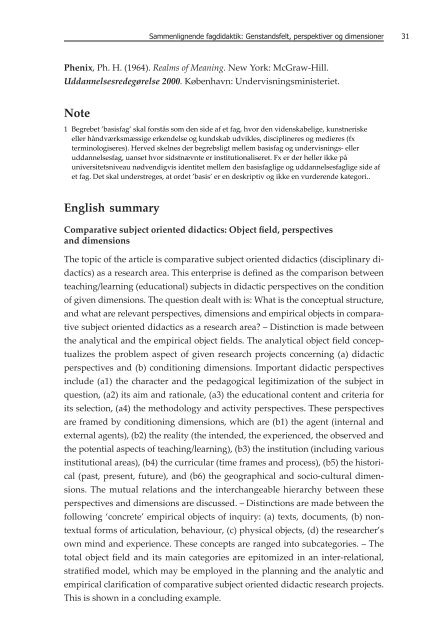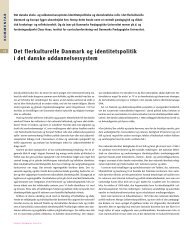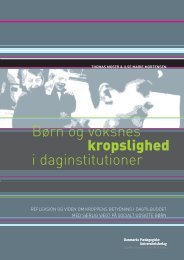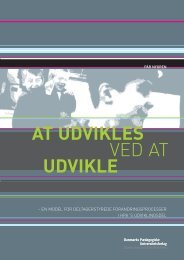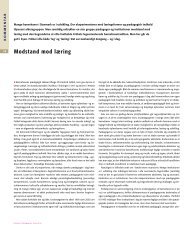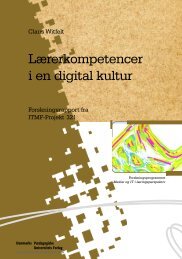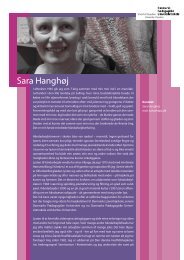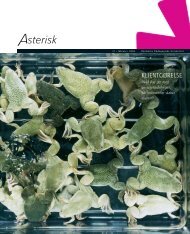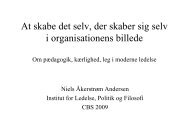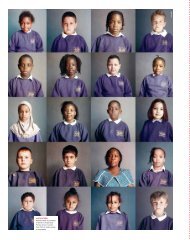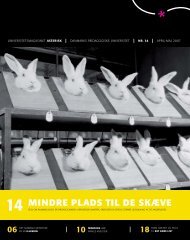Cursiv 7.indd - DPU
Cursiv 7.indd - DPU
Cursiv 7.indd - DPU
Create successful ePaper yourself
Turn your PDF publications into a flip-book with our unique Google optimized e-Paper software.
Phenix, Ph. H. (1964). Realms of Meaning. New York: McGraw-Hill.<br />
Uddannelsesredegørelse 2000. København: Undervisningsministeriet.<br />
Note<br />
1 Begrebet ’basisfag’ skal forstås som den side af et fag, hvor den videnskabelige, kunstneriske<br />
eller håndværksmæssige erkendelse og kundskab udvikles, disciplineres og medieres (fx<br />
terminologiseres). Herved skelnes der begrebsligt mellem basisfag og undervisnings- eller<br />
uddannelsesfag, uanset hvor sidstnævnte er institutionaliseret. Fx er der heller ikke på<br />
universitetsniveau nødvendigvis identitet mellem den basisfaglige og uddannelsesfaglige side af<br />
et fag. Det skal understreges, at ordet ’basis’ er en deskriptiv og ikke en vurderende kategori..<br />
English summary<br />
Sammenlignende fagdidaktik: Genstandsfelt, perspektiver og dimensioner<br />
Comparative subject oriented didactics: Object fi eld, perspectives<br />
and dimensions<br />
The topic of the article is comparative subject oriented didactics (disciplinary didactics)<br />
as a research area. This enterprise is defi ned as the comparison between<br />
teaching/learning (educational) subjects in didactic perspectives on the condition<br />
of given dimensions. The question dealt with is: What is the conceptual structure,<br />
and what are relevant perspectives, dimensions and empirical objects in comparative<br />
subject oriented didactics as a research area? – Distinction is made between<br />
the analytical and the empirical object fi elds. The analytical object fi eld conceptualizes<br />
the problem aspect of given research projects concerning (a) didactic<br />
perspectives and (b) conditioning dimensions. Important didactic perspectives<br />
include (a1) the character and the pedagogical legitimization of the subject in<br />
question, (a2) its aim and rationale, (a3) the educational content and criteria for<br />
its selection, (a4) the methodology and activity perspectives. These perspectives<br />
are framed by conditioning dimensions, which are (b1) the agent (internal and<br />
external agents), (b2) the reality (the intended, the experienced, the observed and<br />
the potential aspects of teaching/learning), (b3) the institution (including various<br />
institutional areas), (b4) the curricular (time frames and process), (b5) the historical<br />
(past, present, future), and (b6) the geographical and socio-cultural dimensions.<br />
The mutual relations and the interchangeable hierarchy between these<br />
perspectives and dimensions are discussed. – Distinctions are made between the<br />
following ‘concrete’ empirical objects of inquiry: (a) texts, documents, (b) nontextual<br />
forms of articulation, behaviour, (c) physical objects, (d) the researcher’s<br />
own mind and experience. These concepts are ranged into subcategories. – The<br />
total object fi eld and its main categories are epitomized in an inter-relational,<br />
stratifi ed model, which may be employed in the planning and the analytic and<br />
empirical clarifi cation of comparative subject oriented didactic research projects.<br />
This is shown in a concluding example.<br />
31


